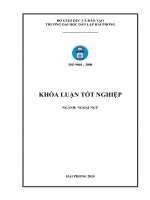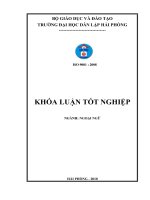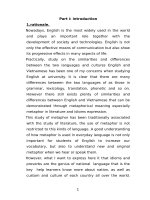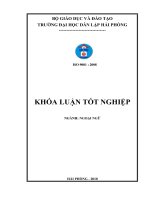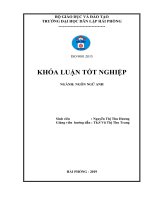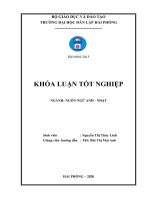A STUDY ON ENGLISH TERMS RELATED TO INVESTMENT DOCUMENTS AND VIETNAMESE EQUIVALENCE
Bạn đang xem bản rút gọn của tài liệu. Xem và tải ngay bản đầy đủ của tài liệu tại đây (1.37 MB, 56 trang )
BỘ GIÁO DỤC VÀ ĐÀO TẠO
TRƯỜNG ĐẠI HỌC DÂN LẬP HẢI PHỊNG
-------------------------------
ISO 9001 : 2008
KHĨA LUẬN TỐT NGHIỆP
NGÀNH: NGOẠI NGỮ
HẢI PHÒNG - 2010
HAIPHONG PRIVATE UNIVESITY
FOREIGN LANGUAGES DEPARTMENT
-----------------------------------
GRADUATION PAPER
A STUDY ON ENGLISH TERMS RELATED TO
INVESTMENT DOCUMENTS AND VIETNAMESE
EQUIVALENCE
By:
LƯU THỊ THÙY DƯƠNG
Class:
NA1002
Supervisor:
NGUYỄN THỊ PHI NGA, M.A.
HAI PHONG - 2010
BỘ GIÁO DỤC VÀ ĐÀO TẠO
TRƯỜNG ĐẠI HỌC DÂN LẬP HẢI PHÒNG
--------------------------------------
Nhiệm vụ đề tài tốt nghiệp
Sinh viên: ..........................................................Mã số:............................
Lớp: ..........................Ngành:....................................................................
Tên đề tài: .................................................................................................
..............................................................................................
..............................................................................................
..............................................................................................
Nhiệm vụ đề tài
1. Nội dung và các yêu cầu cần giải quyết trong nhiệm vụ đề tài tốt
nghiệp
( về lý luận, thực tiễn, các số liệu cần tính tốn và các bản vẽ).
……………………………………………………………………………..
……………………………………………………………………………..
……………………………………………………………………………..
……………………………………………………………………………..
……………………………………………………………………………..
……………………………………………………………………………..
……………………………………………………………………………..
……………………………………………………………………………..
2. Các số liệu cần thiết để thiết kế, tính tốn.
……………………………………………………………………………..
……………………………………………………………………………..
……………………………………………………………………………..
……………………………………………………………………………..
……………………………………………………………………………..
……………………………………………………………………………..
……………………………………………………………………………..
……………………………………………………………………………..
……………………………………………………………………………..
3. Địa điểm thực tập tốt nghiệp.
……………………………………………………………………………..
……………………………………………………………………………..
……………………………………………………………………………..
CÁN BỘ HƯỚNG DẪN ĐỀ TÀI
Người hướng dẫn thứ nhất:
Họ và tên:.............................................................................................
Học hàm, học vị:...................................................................................
Cơ quan công tác:.................................................................................
Nội dung hướng dẫn:............................................................................
Người hướng dẫn thứ hai:
Họ và tên:.............................................................................................
Học hàm, học vị:...................................................................................
Cơ quan công tác:.................................................................................
Nội dung hướng dẫn:............................................................................
Đề tài tốt nghiệp được giao ngày 12 tháng 04 năm 2010
Yêu cầu phải hoàn thành xong trước ngày 10 tháng 07 năm 2010
Đã nhận nhiệm vụ ĐTTN
Đã giao nhiệm vụ ĐTTN
Người hướng dẫn
Sinh viên
Hải Phòng, ngày tháng năm 2010
HIỆU TRƯỞNG
GS.TS.NGƯT Trần Hữu Nghị
PHẦN NHẬN XÉT TÓM TẮT CỦA CÁN BỘ HƯỚNG DẪN
1. Tinh thần thái độ của sinh viên trong quá trình làm đề tài tốt
nghiệp:
……………………………………………………………………………..
……………………………………………………………………………..
……………………………………………………………………………..
……………………………………………………………………………..
……………………………………………………………………………..
……………………………………………………………………………..
……………………………………………………………………………..
……………………………………………………………………………..
2. Đánh giá chất lượng của khóa luận (so với nội dung yêu cầu đã đề ra
trong nhiệm vụ Đ.T. T.N trên các mặt lý luận, thực tiễn, tính tốn số
liệu…):
……………………………………………………………………………..
……………………………………………………………………………..
……………………………………………………………………………..
……………………………………………………………………………..
……………………………………………………………………………..
……………………………………………………………………………..
……………………………………………………………………………..
……………………………………………………………………………..
……………………………………………………………………………..
3. Cho điểm của cán bộ hướng dẫn (ghi bằng cả số và chữ):
……………………………………………………………………………..
……………………………………………………………………………..
……………………………………………………………………………..
Hải Phòng, ngày ….. tháng ..… năm 2010
Cán bộ hướng dẫn
(họ tên và chữ ký)
NHẬN XÉT ĐÁNH GIÁ
CỦA NGƯỜI CHẤM PHẢN BIỆN ĐỀ TÀI TỐT NGHIỆP
1. Đánh giá chất lượng đề tài tốt nghiệp về các mặt thu thập và phân tích tài
liệu, số liệu ban đầu, giá trị lí luận và thực tiễn của đề tài.
2. Cho điểm của người chấm phản biện :
(Điểm ghi bằng số và chữ)
Ngày.......... tháng......... năm 2010
Người chấm phản biện
ACKNOWLEDGEMENT
During the process of doing this graduation paper, I have received many
necessary assistances, previous ideas and timely encouragements from my
teachers, family and friends.
First of all, I wish to express my deepest gratitude to my supervisor – Mrs
Nguyen Thi Phi Nga, MA of Foreign Language Department, who has always
been willing to give me valuable advices and suggestions in order that I can
complete successfully this study.
My sincere thanks are also sent to the teachers in the English Department of
Hai Phong Private University for their useful lessons and whole-hearted
advices during four years studying here.
Last but not least, I would like to give heartfelt thanks to my family, my
friends and the staffs in Department of Planning and Investment who I never
have enough words to express my great gratitude for all their helps,
encouragements and supports.
Hai Phong, June 2010
Student
Luu Thi Thuy Duong
TABLE OF CONTENT
Acknowledgement
Table of content
PART I: INTRODUCTION………………………………………………………………………
1
1. Rationale of the study………………………………………………………………………………..
1
2. Aims of the study………………………………………………………………………………………
2
3. Scope of the study……………………………………………………………………………………...
2
4. Method of the study…………………………………………………………………………………..
3
5. Design of the study……………………………………………………………………………………
3
PART II: DEVELOPMENT……………………………………………………………………..
4
Chapter 1: Theoretical Background
1. Translation theory…………………………………………………………………………………..
4
1.1. Definition of translation…………………………………………………………………………
4
1.2. Translation types…………………………………………………………………………………….
6
1.3. Translation equivalence…………………………………………………………………………
9
1.4. Types of equivalence……………………………………………………………………………... 10
1.5. Case of non-equivalence………………………………………………………………………..
11
2. Translation of English for specific purposes (ESP)…………………………… 11
2.1. Definitions of ESP………………………………………………………………………………….. 11
2.2. Types of ESP………………………………………………………………………………………….. 13
2.3. Investment ESP translation…………………………………………………………………… 15
2.3.1. Definitions of technical translation……………………………………………………. 15
2.3.2. Translation of the area of Investment terms……………………………………… 16
2.4. Terms in Investment field……………………………………………………………………… 16
2.4.1. What is term? ................................................................................................................................... 16
2.4.2. The characteristic of term…………………………………………………………………...
17
2.4.3. Investment terms…………………………………………………………………………………
17
Chapter 2: An investigation of Investment English terms and their
Vietnamese equivalence
1.Collection of English Investment terms and Vietnamese
equivalence…………………………………………………………………………………………………… 19
1.1. Single terms……………………………………………………………………………………………. 19
1.2. Compound terms……………………………………………………………………………………. 22
1.3. Phrases……………………………………………………………………………………………………
25
1.4. Abbreviation………………………………………………………………………………………….
26
2. Strategies applied to translation of English Investment terms into
Vietnamese……………………………………………………………………………………………………. 27
2.1. The strategies applied to the translation of single terms……………………… 27
2.1.1. Recognize translation………………………………………………………………………….. 28
2.1.2. Translation by paraphrase using unrelated words……………………………..
30
2.1.3. Single terms are formed by the help of prefixes……………………………...... 31
2.1.4. Single terms are formed by the help of suffixes………………………………..
34
2.2. The strategies applied to the translation of compound terms………………
36
2.2.1. Shift or transposition of translation……………………………………………………
37
2.2.2. Rank-shift translation………………………………………………………………………….
41
2.3. Strategies applied to the translation of phrases…………………………………….
43
2.3.1. Reduction translation………………………………………………………………………….. 43
2.3.2. Expansion translation………………………………………………………………………….
44
2.4. Translation of abbreviations by using a loan word………………………………
47
Chapter 3: Main Finding
1. The difficulties in translating some Investment terms…………………………… 51
2. Some suggestions in translating Investment terms…………………………………
52
PART III: CONCLUSION………………………………………………………………………… 54
REFERENCES……………………………………………………………………………………………. 56
ABBREVIATIONS
Adj
Adjective
ESP
English for Specific Purposes
N
Noun
SL
Source language
ST
Source text
TL
Target language
TT
Target text
V
Verb
Part I:
INTRODUCTION
1. Rationale of the study
English nowadays is such a common language and it is learned and used everywhere.
English is considered the first language at 28 countries and the second language at many
others such as Singapore, India, Canada, Ireland, and so on. Furthermore, English becomes
an international language which is used worldwide in many fields like Internet, Business,
Education, Communication, Economy, and so on. When you look at the number of people
who speak English and what English is used for, you can realize the importance of English
in life.
Nowadays, Viet Nam economy is developing and opening for all the companies, factories,
corporations and businesses in the world to invest in it. Therefore, teaching and learning
English is quite necessary; especially, English in Investment field because this is the
important field in Vietnam economy. Investment is a new field in Viet Nam integration
process of the globalization. However, people working in Investment field do not have high
standard in English. Thus, a number of Vietnamese learners get trouble in translating
Investment terms, I myself often become confused with terminologies in this field
whenever I meet them. Hence, it is very necessary for me to acquire certain accumulation
of linguistic and cultural knowledge in both native language and foreign languages.
Moreover, I am also interested in translation skills, especially in translation of Investment
terms. That is the reason why I decide to carry out this research. More importantly,
studying this theme offers me a chance to have thorough understanding about English
specific purpose as well as improve knowledge about Investment field.
2. Aims of the study
I carry out the study on English terms related to Investment documents to figure out an
overview on translation and translation strategies in general and translation of Investment
terms in particular.
In details, the study is aimed at:
Understanding thoroughly translation theory and translation of English specific purpose
Collecting and presenting common English terms relating to Investment Documents and
their Vietnamese equivalents
Giving some suggestions to readers who pay attention to translation skill and Investment
field
I hope that this study can help readers to understand about translation strategies in general
and translation of Investment terms in particular, help them translate it effectively.
3. Scope of the study
The terms used in Investment field would require a great amount of effort and time to
study. However, due to limitation of time and my knowledge, my study could not cover all
the aspect of this theme. I only focus the study on translation and translation strategies in
general, and translation of English terms relating to Investment documents. But hopefully
these will partly help readers have the general knowledge and understanding about these
terms which are used in Investment field.
4. Method of the study
To carry out and complete successfully this research, I used the following methods:
Reading translation books to understand theoretical background.
Asking my supervisors, teachers and friends
Collecting documents and information related to Investment field from Internet,
TV, references books, newspapers, Dictionary and so on.
5. Design of the study
My graduation paper includes three main parts:
Part I, INTRODUCTION includes reason of the study, aims of the study, scope of the
study, method of the study, design of the study.
Part II, DEVELOPMENT is the main part of the research paper and it is divided into 3
chapters:
Chapter I is THEORETICAL BACKGROUND providing the definition, type and
strategies of translation in general and ESP translation in general and ESP in Investment
terms.
Chapter II is AN INVESTIGATION OF ENGLISH TERMS RELATING TO
INVESTMENT DOCUMENTS AND VIETNAMESE EQUIVALENCE
Chapter III is the MAIN FINDING of my research.
Part III is CONCLUSION with the summary of what has been given in the previous parts
and Reference.
Part II:
Chapter I:
DEVELOPMENT
THEORETICAL BACKGROUND
1. Translation theory
1.1 Definitions of translation:
There are many definitions of translation all over the world. Following is some typical
definitions :
The first definition is “Translation is the replacement of textual material in one language
by equivalent textual material in another language”
_Catford (1965: 20)_
Very much similar to this definition is “Translation is made possible by an equivalent of
thought that lies behind its different verbal expressions”
_Savory (1968: 37)_
Next, the process of translating as follows.
“Translating consists of reproducing in the receptor language the closest natural equivalent
of the source language message, first in terms of meaning and secondly in terms of style.”
_Nida and Taber (1959: 19)_
In Translation: Applications and Research, defines translation as:
“The general term referring to the transfer of thoughts and ideas from one language
(source) to another (target), whether the languages are in written or oral form; whether the
languages have established orthographies or do not have such standardization or whether
one or both languages is based on signs, as with sign languages of the deaf”
_ Brislin (1976: 1)_
Identical with the above definition is "Translation is a process of finding a TL equivalent
for an SL utterance"
_ Pinhhuck (1977: 38)_
In 1980, McGuire defined translation as “Translation involves the rendering of a source
language (SL) text into the target language (TL) so as to ensure that the surface meaning of
the two will be approximately similar and the structure of the SL will be preserved as
closely as possible, but not so closely that the TL structure will be seriously distorted”
_McGuire (1980: 2)_
Some scholars defined translation as an art / craft:
“Translation is a craft consisting in the attempt to replace a written message and/or
statement in one language by the same message and/or statement in another language”
_Newmark (1981: 7)_
Wills defines translation more or less similarly as follows.
“Translation is a transfer process which aims at the transformation of a written SL text into
an optimally equivalent TL text, and which requires the syntactic, the semantic and the
pragmatic understanding and analytical processing of the SL”
_Wills in Noss (1982: 3)_
According to Bell:
“Translation is the transformation of a text originally in one language into an equivalent
text in a different language retaining, as far as possible, the content of the message and the
formal features and functional roles of the original text”
_Bell (1991: xv)_
“Translation, as process of conveying messages across the linguistic and cultural barriers,
is an eminently communicative activity, one whose use could be well considered in a wider
range of teaching situation than may currently be the case”
_Tudor, cited in Duff (1989: 5)_
Although these definitions are different in expression, they share common features about
finding the closest equivalence in meaning by the choice of appreciate target language’s
lexical and grammatical structures, communication situation, and cultural context. Some
sort of movement from one language to another depends on translation types that will be
show in the next part.
1.2 Translation types:
There are some translation types as following:
SL Emphasis
TL Emphasis
Word-for-word translation
Adaptation
Literal translation
Free translation
Faithful translation
Idiomatic translation
Semantic translation
Communicative translation
a)Word- for- word translation: In which the SL word order is preserved and the words
translated singly by their most common meanings. Cultural words are translated literally.
The main use of this method is either to understand the mechanics of the source language
or to construe a difficult text as pre-translation process
Example: This house was built by my grandfather.
Căn nhà này được xây bởi ông nội tôi
b)Literal translation: This is a broader form of translation, each SL word has a
corresponding TL word, but their primary meaning may differ. The SL grammatical forms
are converted to their nearest target language equivalents. However, the lexical words are
again translated out of context. Literal translation is considered the basic translation step,
both in communication and semantic translation, in that translation starts from there. As
pre-translation process, it indicates problems to be solved.
Example: My sister put all her whole savings to buy this car
Chị gái tơi đã dùng tồn bộ số tiền tiết kiệm để mua chiếc xe này.
c)Faithful translation: This method tries to reproduce the precise contextual meaning of
the original within the constraint of the TL grammatical structures. It transfers cultural
words and preserves the degree of grammatical and lexical deviation from SL norms. It
attempts to be completely faithful to the intentions and the text-realization of the SL writer
Example: Sông Hương
Faithful translation: The Perfume River
d)Semantic translation: It differs from faithful translation only in as far as it must take
more account of the aesthetic value of the SL text, compromising on meaning where
appropriate so that no assonance, word play, or repetition jars in the finished version.
Example: Today the Vietnamese are, almost no exception, extremely friendly to Western
visitors
Ngày nay, người Việt Nam đều rất thân thiện với các khách du lị ch nước ngoài.
(Text book for Translation 1-Haiphong private university)
e)Free translation: This method of translation produces the translated text without the
style, form, or content of the original text.
Example:
“On the bright moonlit nights, standing on the bridge you can see myriads of stars
reflecting on the blue water. The wind breeze rising from the river caresses your lung with
fragrance”
“Đ
ứng trên cầu vào những đêm trăng sáng bạn sẽ được thỏa sức nhìn ngắm hằng hà sa số
những vì sao lấp lánh soi mình xuống làn nước trong xanh. Ngọn gió nhẹ nhàng mát dị u
đưa từ ngồi sơng vào mơn trớn vuốt ve da thị t bạn, làm căng lồng ngực bạn bằng hương
thơm êm dị u”.
f)Adaptation: Adaptation refers to that type of translation which is used mainly for plays
and poems. The text is rewritten considering the source language culture which is
converted to the target language culture where the characters, themes, plots are usually
preserved
Example:
Thà một phút huy hồng rồi chợt tắt
Cịn hơn buồn le lói suốt trăm năm
(Xuân Diệu)
It would rather the victorious brightness
In an only moment the centenary twinkle
g)Idiomatic translation: It translates the message of the original text but tends to distort
the original meaning at times by preferring colloquialisms and idioms.
Candle in the wind
Example:
Đ khoe đèn tỏ hơn trăng
èn
Đ ra trước gió cịn chăng hỡi đèn
èn
h)Communicative translation: This method displays the exact contextual meaning of the
original text in a manner where both content and language are easily acceptable and
comprehensible to the readers.
Example: Hello! How are you?
Ê, lâu lắm không gặp, dạo này bạn thế nào?
1.3 Translation equivalence:
According to Vanessa Leonardo “Equivalence can be said to be the central issue in
translation although its definition, relevance, and applicability within the field of translation
theory have caused heated controversy, and many different theories of the concept of
equivalence have been elaborated within this field in the past fifty years.”
Following are some other definitions of translation equivalence:
Equivalence-oriented translation is a procedure which replicates the same situation
as in the original, whilst using completely different wording.
_Vinay and Darbelnet_
Translation equivalence exists between forms in a source language and a target
language if their meaning matches. In other words, translation equivalence should
answer the question “What do the speakers of this language actually say to express
the desired meaning?”
_Wayne Leman (Wordpress.com)_
Equivalence, when applied to the issue of translation, is an abstract concept and
actually refers to the equivalence relationship between the source text and the target
text.
_Asian social science(CCSE)_
1.4 Types of equivalence:
Nida (1969) argued that there are two different types of equivalence, namely formal
equivalence which in the second edition by Nida and Taber (1982:200) is referred to as
formal correspondence and dynamic equivalence.:
Formal equivalence is achieved when source language and target language words have the
closest possible match of form and content.
Dynamic equivalence is achieved when the source language and the target language words
have the same effect on their effective readers.
Keller (1979: 188-89) considers fives types of equivalence:
Denotative equivalence: the SL and the TL words refer to the same thing in the real world.
It is an equivalence of the extra linguistic content of a text.
Connotative equivalence: This type of equivalence provides additional value and is
achieved by the translator’s choice of synonymous words of expressions.
Text-normative equivalence: The SL and the TL words are used in the same or similar
context in their respective languages.
Pragmatic equivalence: With readership orientation, the SL and TL words have the same
effect on their respective readers.
Formal equivalence: This type of equivalence produces an analogy of form in the
translation by either exploiting formal possibilities of TL, or creating new forms in TL.
Although equivalence translation is deferent point of view of theorists, it is same effective
equivalence between SL and TL.
1.5 Case of non-equivalence:
Non-equivalence can be divided into two basic categories :
Non-equivalence at word level
Non-equivalence above word level
According to Mona Baker, the concept of non-equivalence at word level is more and less as
follow:“ Non-equivalence at word level means that the target language has no direct
equivalence for a word which occurs in the source text”
In the original English book, there are many special expressions which do not have suitable
counterparts in other language. This means that it is not possible to translate these
expressions by applying typical translational methods and strategies
2. Translation
of English for specific purposes (ESP)
2.1 Definition of ESP:
ESP began in the 1960s, but some of famous linguisticians build on earlier definitions.
According to Hutchinson and Waters (1987:19), “ESP must be seen as an approach not as a
product, ESP is not a particular kind of language, or methodology, nor does it consist of a
particular type of teaching material. Understood properly, it is an approach to language
learning, which is based on learner need”.
Stevens’(1988) definition of ESP makes a distinction between four absolute characteristics
and two variable characteristics. The absolute characteristics are that ESP consists of
English Language Teaching which is:
Designed to meet specified needs of the learner;
Related in content (that is in its themes and topics) to particular disciplines,
occupations and activities;
Centered on language appropriate to those activities in syntax, lexis, discourse,
semantics and so on, and analysis of the discourse;
In contrast with “General English”.
The variable characteristics are that ESP
May be restricted as to the learning skills to be learned (for example reading only);
May not be taught according to any pre-ordained methodology.
Robinson in her second survey of ESP in 1991 also accepted the primacy of needs analysis
in defining ESP. Her definition is based on two key definition criteria and a number of
characteristics that are generally found to be true of ESP. Her key criteria are that ESP is
“normally goal-directed”, and that ESP course develop from a needs analysis, which “aims
to specify as closely as possible what exactly it is that students have to do through the
medium of English” (Robinson, 1991: 3).
From looking at three definitions of ESP found in the literature, finally, Tony DudleyEvans and Maggie Jo St John (1998, 2) defined ESP by using absolute and variable
characteristics that is:
Absolute characteristics:
ESP is designed to meet specific needs of the learner;
ESP makes use of the underlying methodology and activities of the disciplines it serves;
ESP is centred on the language (grammar, lexis, and register), skills, discourse and genres
appropriate to these activities.
Variable characteristics:
ESP may be related to or designed for specific disciplines;
ESP may use, in specific teaching situations, a different methodology from that of general
English;
ESP is likely to be designed for adult learner, either at a tertiary level institution or in a
professional work situation. It could, however, be used for learners at secondary school
level;
ESP is generally designed for intermediate or advanced students. Most ESP courses basic
knowledge of the language system, but it can be used with beginners.
2.2 Types of ESP:
Types of ESP are identified three types by David Carter(1983):
English as a restricted language
English for Academic and Occupational Purpose
English with specific topics
The language used by air traffic controllers or by waiters are examples of English as a
restricted language. Mackay and Mountford (1978) clearly illustrate the difference between
restricted language and language with this statement:
... The language of international air-traffic control could be regarded as 'special', in the
sense that the repertoire required by the controller is strictly limited and can be accurately
determined situational, as might be the linguistic needs of a dining-room waiter or airhostess. However, such restricted repertoires are not languages, just as a tourist phrase
book is not grammar. Knowing a restricted 'language' would not allow the speaker to
communicate effectively in novel situation, or in contexts outside the vocational
environment (pp. 4-5).
The second type of ESP identified by Carter (1983) is English for Academic and
Occupational Purposes. In the 'Tree of ELT' (Hutchinson & Waters, 1987), ESP is broken
down into three branches: a) English for Science and Technology (EST), b) English for
Business and Economics (EBE), and c) English for Social Studies (ESS). Each of these
subject areas is further divided into two branches: English for Academic Purposes (EAP)
and English for Occupational Purposes (EOP). An example of EOP for the EST branch is
'English for Technicians' whereas an example of EAP for the EST branch is 'English for
Medical Studies'.
Hutchinson and Waters (1987) do note that there is not a clear-cut distinction
between EAP and EOP: "· people can work and study simultaneously; it is
also likely that in many cases the language learnt for immediate use in a study
environment will be used later when the student takes up, or returns to, a job"
(p. 16). Perhaps this explains Carter's rationale for categorizing EAP and EOP
under the same type of ESP. It appears that Carter is implying that the end
purpose of both EAP and EOP are one in the same: employment. However,
despite the end purpose being identical, the means taken to achieve the end is
very different indeed. I contend that EAP and EOP are different in terms of
focus on Cummins' (1979) notions of cognitive academic proficiency versus
basic interpersonal skills. This is examined in further detail below.
The third and final type of ESP identified by Carter (1983) is English with
specific topics. Carter notes that it is only here where emphasis shifts from
purpose to topic. This type of ESP is uniquely concerned with anticipated
future English needs of, for example, scientists requiring English for
postgraduate reading studies, attending conferences or working in foreign
institutions. However, I argue that this is not a separate type of ESP. Rather it
is an integral component of ESP courses or programs which focus on
situational language. This situational language has been determined based on
the interpretation of results from needs analysis of authentic language used in
target workplace settings.
2.3 Investment ESP translation:
Investment ESP translation is recently very important because most
Investment documents are written in English which needs to understand
deeply. And, it is impossible to contrast a complete translation that captures
the universal meaning of the SL in the Investment text without the full
understanding about Investment terms which is an issue relevant to technical
translation. Thus, this part of the study is based on the theoretical background
of technical translation.
2.3.1 Definitions of technical translation:
Sofer (1991) as follow distinguishes technical translation from literal translation: “The
main division in the translation field is between literal and technical translation”.
According to him, literal translation covers such areas fiction, poetry, drama and
humanities in general and is done by writers of the same kind in the TL, or at least by
translators with the required literary aptitude. Meanwhile, technical translation is done by
much greater number of practitioners and is an ever-going and expanding field with
excellent opportunities.
Newmark (1981) differently distinguishes technical translation from
institutional translation: “Technical translation is one of the part of specialized
translation; institutional translation, the areas of politics, commerce, finance,
government etc… is the other.” He goes on to suggest that technical
translation is potentially non-cultural and universal because the benefits of
technology are not confined to one speech community. The terms in technical
translation, therefore should be translated. On the contrary, institutional
translation is cultural, so, in principle, the terms are transferred unless they are
connected with international organization. Though having different
approaches to technical translation, two authors view it as specialized
translation with its essential element – “special terms”.
2.3.2 Translation in the area of Investment terms:
Investment term is one of the popular specific fields, like other languages, its
terminologies can change over time. If we translate in the Investment field,
we must find the correct terminology used in the translation. Therefore, it
would be very helpful for our translation if we are constantly updating
glossaries related to the field as a whole, as well as specific Investment topics.
Besides, translation of Investment terms is quite complex, we are required
translational skills and domain knowledge to include the fields of Investment.
Moreover, we need to know more deeply about its word building, so the next
– terms in Investment field will show more in details.
2.4 Terms in Investment field
2.4.1 What is term?
Technical terminology is the specialized vocabulary of a field, the
nomenclature. These terms have specific definitions within the field, which is
not necessarily the same as their meaning in common use.
( />A term is a word or expression that has a particular meaning or is used in particular
activity, job, profession, etc (Longman Dictionary of Contemporary English, 1991)
Term is the variation of language in a specific condition (Peter Newmark) and he stated
that the central difficulty in translation is usually the new terminology. Even then, the main
problem is likely to be that of some terms in the source text which are relatively contextfree, and appear only once. If they are context-bound, you are more likely to understand
them by gradually eliminating the less likely versions.
2.4.2 The characteristics of terms:
There is a distinction between technical and descriptive terms.The original source language
may use a descriptive term for a technical object for three reasons:
The object is new, and not yet has a name
The descriptive term is being used as familiar alternative, to avoid repetition
The descriptive term is being used to make a contrast with another one.
2.4.3 Investment terms:
According to structure, investment terms consist of following types;
Single terms are those that consist of just one word (compound or derived).
Example: investment, agreement, investor, contract, proposal, project, reinvestment, sector,
capital, employer, etc.
Compound terms are terms consisting of two or more words, most of them are compound
nouns, compound adjectives, etc.
Example: safety procedure, advance payment, Invested capital, investment documents,
foreign investor, etc.
Phrases: Most of them are noun phrases, used usually in titles of section in guidelines or
documents.
Example: the minimum capital contribution, State management of
foreign investment, investment in research and development, an
enterprise with foreign owned capital, etc.
Abbreviation:
Example: NAV (Net Asset Value), PMU ( Project Management Unit),
BD ( Basic Design), CIP ( Construction Investment Project), etc.
All types of terms will be presented in detail in the next chapter.
